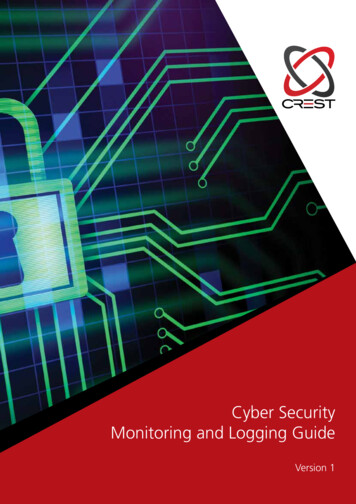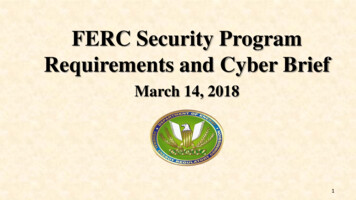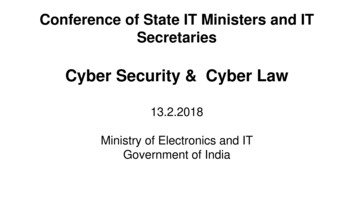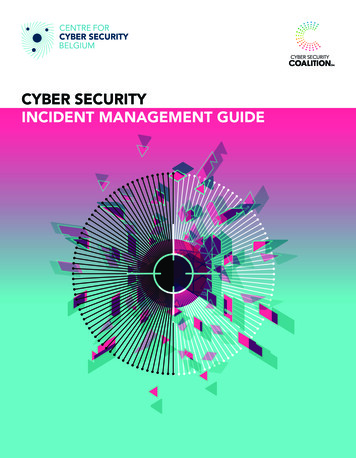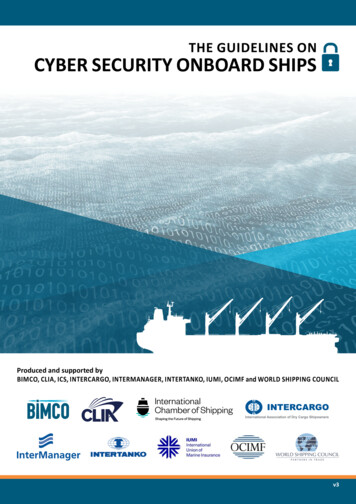
Transcription
THE GUIDELINES ONCYBER SECURITY ONBOARD SHIPSProduced and supported byBIMCO, CLIA, ICS, INTERCARGO, INTERMANAGER, INTERTANKO, IUMI, OCIMF and WORLD SHIPPING COUNCILv3
The Guidelines on Cyber Security Onboard ShipsVersion 3Terms of useThe advice and information given in the Guidelines on Cyber Security Onboard Ships (the guidelines)is intended purely as guidance to be used at the user’s own risk. No warranties or representationsare given, nor is any duty of care or responsibility accepted by the Authors, their membership oremployees of any person, firm, corporation or organisation (who or which has been in any wayconcerned with the furnishing of information or data, or the compilation or any translation, publishing,or supply of the guidelines) for the accuracy of any information or advice given in the guidelines; or anyomission from the guidelines or for any consequence whatsoever resulting directly or indirectly fromcompliance with, adoption of or reliance on guidance contained in the guidelines, even if caused by afailure to exercise reasonable care on the part of any of the aforementioned parties.
ContentsIntroduction. 7.37.4Cyber security and safety management. 3Differences between IT and OT systems. 5Plans and procedures. 6Relationship between ship manager and shipowner. 7The relationship between the shipowner and the agent. 7Relationship with vendors. 8Identify threats. 9Identify vulnerabilities. 13Ship to shore interface. 14Assess risk exposure. 16Risk assessment made by the company. 21Third-party risk assessments. 21Risk assessment process. 22Develop protection and detection measures. 24Defence in depth and in breadth. 24Technical protection measures. 25Procedural protection measures. 29Establish contingency plans. 34Respond to and recover from cyber security incidents. 36Effective response. 36Recovery plan. 37Investigating cyber incidents. 38Losses arising from a cyber incident. 38Annex 1Annex 2Annex 3Annex 4Annex 5Target systems, equipment and technologies. 40Cyber risk management and the safety management system. 42Onboard networks. 46Glossary. 50Contributors to version 3 of the guidelines. 53THE GUIDELINES ON CYBER SECURITY ONBOARD SHIPS V3Contents
IntroductionShips are increasingly using systems that rely on digitisation, digitalisation, integration, andautomation, which call for cyber risk management on board. As technology continues to develop,information technology (IT) and operational technology (OT) onboard ships are being networkedtogether – and more frequently connected to the internet.This brings the greater risk of unauthorised access or malicious attacks to ships’ systems andnetworks. Risks may also occur from personnel accessing systems on board, for example byintroducing malware via removable media.To mitigate the potential safety, environmental and commercial consequences of a cyber incident, agroup of international shipping organisations, with support from a wide range of stakeholders (pleaserefer to annex 5 for more details), have participated in the development of these guidelines, whichare designed to assist companies in formulating their own approaches to cyber risk managementonboard ships.Approaches to cyber risk management will be company- and ship-specific but should be guided by therequirements of relevant national, international and flag state regulations. These guidelines provide arisk-based approach to identifying and responding to cyber threats. An important aspect is the benefitthat relevant personnel would obtain from training in identifying the typical modus operandi of cyberattacks.In 2017, the International Maritime Organization (IMO) adopted resolution MSC.428(98) on MaritimeCyber Risk Management in Safety Management System (SMS). The Resolution stated that anapproved SMS should take into account cyber risk management in accordance with the objectivesand functional requirements of the ISM Code. It further encourages administrations to ensure thatcyber risks are appropriately addressed in safety management systems no later than the first annualverification of the company’s Document of Compliance after 1 January 2021. The same year, IMOdeveloped guidelines1 that provide high-level recommendations on maritime cyber risk managementto safeguard shipping from current and emerging cyber threats and vulnerabilities. As also highlightedin the IMO guidelines, effective cyber risk management should start at the senior management level.Senior management should embed a culture of cyber risk awareness into all levels and departmentsof an organization and ensure a holistic and flexible cyber risk management regime that is incontinuous operation and constantly evaluated through effective feedback mechanisms.The commitment of senior management to cyber risk management is a central assumption, on whichthe Guidelines on Cyber Security Onboard Ships have been developed.The Guidelines on Cyber Security Onboard Ships are aligned with IMO resolution MSC.428(98)and IMO’s guidelines and provide practical recommendations on maritime cyber risk managementcovering both cyber security and cyber safety. (See chapter 1 for this distinction).The aim of this document is to offer guidance to shipowners and operators on procedures and actionsto maintain the security of cyber systems in the company and onboard the ships. The guidelines arenot intended to provide a basis for, and should not be interpreted as, calling for external auditing orvetting the individual company’s and ship’s approach to cyber risk management.Like the IMO guidelines, the US National Institute of Standards and Technology (NIST) frameworkhas also been accounted for in the development of these guidelines. The NIST framework assistscompanies with their risk assessments by helping them understand, manage and express the1MSC-FAL.1/Circ.3 on Guidelines on maritime cyber risk managementTHE GUIDELINES ON CYBER SECURITY ONBOARD SHIPS V3Introduction1
potential cyber risk threat both internally and externally. As a result of this assessment, a “profile” isdeveloped, which can help to identify and prioritise actions for reducing cyber risks. The profile canalso be used as a tool for aligning policy, business and technological approaches to manage the risks.Sample framework profiles are publicly available for maritime bulk liquid transfer, offshore, andpassenger ship operations2. These profiles were created by the United States Coast Guard and NIST’sNational Cybersecurity Center of Excellence with input from industry stakeholders. The profiles areconsidered to be complimentary to these guidelines and can be used together to assist industry inassessing, prioritizing, and mitigating their cyber risks.2The NIST Framework Profiles for maritime bulk liquid transfer, offshore, and passenger operations can be accessed here: nger-vessel-cybersecurity-framework-profiles.THE GUIDELINES ON CYBER SECURITY ONBOARD SHIPS V3Introduction2
1Cyber security and safety managementBoth cyber security and cyber safety are important because of their potential effect on personnel,the ship, environment, company and cargo. Cyber security is concerned with the protection of IT, OT,information and data from unauthorised access, manipulation and disruption. Cyber safety covers therisks from the loss of availability or integrity of safety critical data and OT.Cyber safety incidents can arise as the result of: a cyber security incident, which affects the availability and integrity of OT, for example corruptionof chart data held in an Electronic Chart Display and Information System (ECDIS) a failure occurring during software maintenance and patching loss of or manipulation of external sensor data, critical for the operation of a ship – this includesbut is not limited to Global Navigation Satellite Systems (GNSS).Whilst the causes of a cyber safety incident may be different from a cyber security incident, theeffective response to both is based upon training and awareness.Incident: Unrecognised virus in an ECDIS delays sailingA new-build dry bulk ship was delayed from sailing for several days because its ECDIS was infected by a virus. Theship was designed for paperless navigation and was not carrying paper charts. The failure of the ECDIS appearedto be a technical disruption and was not recognized as a cyber issue by the ship’s master and officers. A producertechnician was required to visit the ship and, after spending a significant time in troubleshooting, discoveredthat both ECDIS networks were infected with a virus. The virus was quarantined and the ECDIS computers wererestored. The source and means of infection in this case are unknown. The delay in sailing and costs in repairstotalled in the hundreds of thousands of dollars (US).Cyber risk management should: identify the roles and responsibilities of users, key personnel, and management both ashore andon board identify the systems, assets, data and capabilities, which if disrupted, could pose risks to the ship’soperations and safety implement technical and procedural measures to protect against a cyber incident and ensurecontinuity of operations implement activities to prepare for and respond to cyber incidents.THE GUIDELINES ON CYBER SECURITY ONBOARD SHIPS V3Cyber security and safety management3
Some aspects of cyber risk management may include commercially sensitive or confidentialinformation. Companies should, therefore, consider protecting this information appropriately, and asfar as possible, not include sensitive information in their Safety Management System (SMS).Identify threatsUnderstand the external cybersecurity threats to the ship.Understand the internal cyber securitythreat posed by inappropriate use andlack of awareness.Respond to andrecover from cybersecurity incidentsRespond to and recover from cybersecurity incidents using thecontingency plan.Assess the impact of theeffectiveness of theresponse plan andre-assess threats andvulnerabilities.EstablishcontingencyplansCYBER RISKMANAGEMENTAPPROACHDevelop a prioritised contingencyplan to mitigate any potentialidentified cyber risk.Develop protectionanddetection measuresIdentifyvulnerabilitiesDevelop inventories of onboardsystems with direct and indirectcommunications links.Understand the consequences of acyber security threat onthese systems.Understand the capabilitiesand limitations of existingprotection measures.Assess riskexposureDetermine the likelihood ofvulnerabilities being exploitedby external threats.Determine the likelihood ofvulnerabilities being exposed byinappropriate use.Determine the security and safetyimpact of any individual orcombination of vulnerabilitiesbeing exploited.Reduce the likelihood of vulnerabilitiesbeing exploited through protectionmeasures.Reduce the potential impactof a vulnerability beingexploited.Figure 1: Cyber risk management approach as set out in the guidelinesDevelopment, implementation, and maintenance of a cyber security management program inaccordance with the approach in figure 1 is no small undertaking. It is, therefore, important thatsenior management stays engaged throughout the process to ensure that the protection, contingencyand response planning are balanced in relation to the threats, vulnerabilities, risk exposure andconsequences of a potential cyber incident.THE GUIDELINES ON CYBER SECURITY ONBOARD SHIPS V3Cyber security and safety management4
1.1 Differences between IT and OT systemsOT systems control the physical world and IT systems manage data. OT systems differ from traditionalIT systems. OT is hardware and software that directly monitors/controls physical devices andprocesses. IT covers the spectrum of technologies for information processing, including software,hardware and communication technologies. Traditionally OT and IT have been separated, but withthe internet, OT and IT are coming closer as historically stand-alone systems are becoming integrated.Disruption of the operation of OT systems may impose significant risk to the safety of onboardpersonnel, cargo, damage to the marine environment, and impede the ship’s operation.Typical differences between IT and OT systems can be seen in the table below.Typical differences between IT and OT systems can be seen in the table below.CategoryIT systemOT systemPerformance requirements non-real-time real-time response must be consistent response is time-critical less critical emergency interaction response to human and any otheremergency interaction is critical tightly restricted access control can beimplemented to the degree necessaryfor securityAvailability (reliability)requirementsRisk managementrequirements responses such as rebooting areacceptable availability requirements maynecessitate back-up systems manage data control physical world data confidentiality and integrity isparamount safety is paramount, followed byprotection of the process fault tolerance may be less important. fault tolerance is essential, evenmomentary downtime may not beacceptable systems are designed for use withcommonly known operating systems upgrades are straightforward with theavailability of automated deploymenttoolsResource constraints responses such as rebooting may notbe acceptable because of operationalrequirements availability deficiencies may betolerated, depending on the system’soperational requirements risk impacts may cause delay of: ship’sclearance, commencement of loading/unloading, and commercial andbusiness operationsSystem operation access to OT should be strictlycontrolled, but should not hamperor interfere with human-machineinteraction risk impacts are regulatory noncompliance, as well as harm to thepersonnel onboard, the environment,equipment and/or cargo differing and possibly proprietaryoperating systems, often without builtin security capabilities software changes must be carefullymade, usually by software vendors,because of the specialized controlalgorithms and possible involvement ofmodified hardware and software systems are specified with enough systems are designed to support theresources to support the addition ofintended operational process andthird-party applications such as securitymay not have enough memory andsolutionscomputing resources to support theaddition of security capabilitiesTable 1: Differences between OT and IT33Based on table 2-1 in NIST Special Publication 800-82, Revision 2.THE GUIDELINES ON CYBER SECURITY ONBOARD SHIPS V3Cyber security and safety management5
There may be important differences between who handles the purchase and management of the OTsystems versus IT systems on a ship. IT departments are not usually involved in the purchase of OTsystems. The purchase of such systems should involve a chief engineer, who knows about the impacton the onboard systems but will most probably only have limited knowledge of software and cyberrisk management. It is, therefore, important to have a dialogue with the IT department to ensurethat cyber risks are considered during the OT purchasing process. OT systems should be inventoriedwith the IT department, so as to obtain an overview of potential challenges and to help establish thenecessary policy and procedures for software maintenance.Other industry sectors have seen the barrier removed between IT and OT, with management andprocurement strategies all handled under the same regime.1.2 Plans and proceduresIMO Resolution MSC.428(98) identifies cyber risks as specific threats, which companies should tryto address as far as possible in the same way as any other risk that may affect the safe operationof a ship and protection of the environment. More guidance on how to incorporate cyber riskmanagement into the company’s SMS can be found in annex 2 of these guidelines.Cyber risk management should be an inherent part of the safety and security culture conducive to thesafe and efficient operation of the ship and be considered at various levels of the company, includingsenior management ashore and onboard personnel. In the context of a ship’s operation, cyberincidents are anticipated to result in physical effects and potential safety and/or pollution incidents.This means that the company needs to assess risks arising from the use of IT and OT onboard shipsand establish appropriate safeguards against cyber incidents. Company plans and procedures forcyber risk management should be incorporated into existing security and safety risk managementrequirements contained in the ISM Code and ISPS Code.The objective of the SMS is to provide a safe working environment by establishing appropriatepractices and procedures based on an assessment of all identified risks to the ship, onboard personneland the environment. The SMS should include instructions and procedures to ensure the safeoperation of the ship and protection of the environment in compliance with relevant internationaland flag state requirements. These instructions and procedures should consider risks arising fromthe use of IT and OT on board, taking into account applicable codes, guidelines and recommendedstandards.When incorporating cyber risk management into the company’s SMS, consideration should be givenas to whether, in addition to a generic risk assessment of the ships it operates, a particular ship needsa specific risk assessment. The company should consider the need for a specific risk assessment basedon whether a particular ship is unique within their fleet. The factors to be considered include but arenot limited to the extent to which IT and OT are used on board, the complexity of system integrationand the nature of operations.In accordance with chapter 8 of the ISPS Code, the ship is obliged to conduct a security assessment,which includes identification and evaluation of key shipboard operations and the associated potentialthreats. As recommended by Part B, paragraph 8.3.5 of the ISPS Code, the assessment should addressradio and telecommunication systems, including computer systems and networks. Therefore, theship’s security plan may need to include appropriate measures for protecting both the equipmentand the connection. Due to the fast adoption of sophisticated and digitalised onboard OT systems,consideration should be given to including these procedures by reference to the SMS in order to helpensure the ship’s security procedures are as up-to-date as possible.Systems like Tanker Management and Self Assessment (TMSA) also require plans and procedures tobe implemented.THE GUIDELINES ON CYBER SECURITY ONBOARD SHIPS V3Cyber security and safety management6
1.3 Relationship between ship manager and shipownerThe Document of Compliance holder is ultimately responsible for ensuring the management of cyberrisks on board. If the ship is under third party management, then the ship manager is advised to reachan agreement with the ship owner.Particular emphasis should be placed by both parties on the split of responsibilities, alignment ofpragmatic expectations, agreement on specific instructions to the manager and possible participationin purchasing decisions as well as budgetary requirements.Apart from ISM requirements, such an agreement should take into consideration additional applicablelegislation like the EU General Data Protection Regulation (GDPR) or specific cyber regulations inother coastal states. Managers and owners should consider using these guidelines as a base for anopen discussion on how best to implement an efficient cyber risk management regime.Agreements on cyber risk management should be formal and written.1.4 The relationship between the shipowner and the agentThe importance of this relationship has placed the agent4 as a named stakeholder, interfacingcontinuously and simultaneously with shipowners, operators, terminals, port services vendors, andport state control authorities through the exchange of sensitive, financial, and port coordinationinformation. The relationship goes beyond that of a vendor. It can take different forms and especiallyin the tramp trade, shipowners require a local representative (an independent ship agent) to serve asan extension of the company.Coordination of the ship’s call of port is a highly complex task being simultaneously global and local.It covers updates from agents, coordinating information with all port vendors, port state control,handling ship and crew requirements, and electronic communication between the ship, port andauthorities ashore. As one example, which touches cyber risk management: Often agents are requiredto build IT systems, which upload information real-time into owner’s management informationsystem.Quality standards for agents are important because like all other businesses, agents are also targetedby cyber criminals. Cyber-enabled crime, such as electronic wire fraud and false ship appointments,and cyber threats such as ransomware and hacking, call for mutual cyber strategies and cyberenhanced relationships between owners and agents to mitigate such cyber risks.Incident: Ship agent and shipowner ransomware incidentA shipowner reported that the company’s business networks were infected with ransomware, apparently froman email attachment. The source of the ransomware was from two unwitting ship agents, in separate ports, andon separate occasions. Ships were also affected but the damage was limited to the business networks, whilenavigation and ship operations were unaffected. In one case, the owner paid the ransom5.The importance of this incident is that harmonized cyber security across relationships with trusted businesspartners and producers is critical to all in the supply chain. Individual efforts to fortify one’s own business can bevaliant and well-intended but could also be insufficient. Principals in the supply chain should work together tomitigate cyber risk.45The party representing the ship’s owner and/or charterer (the Principal) in port. If so instructed, the agent is responsible to the principal for arranging,together with the port, a berth, all relevant port and husbandry services, tending to the requirements of the master and crew, clearing the ship withthe port and other authorities (including preparation and submission of appropriate documentation) along with releasing or receiving cargo on behalfof the principal (source: Convention on Facilitation of International Maritime Traffic (FAL Convention).Nothing in these guidelines should be taken as recommending the payment of ransom.THE GUIDELINES ON CYBER SECURITY ONBOARD SHIPS V3Cyber security and safety management7
1.5 Relationship with vendorsCompanies should evaluate and include the physical security and cyber risk management processesof service providers in supplier agreements and contracts. Processes evaluated during supplier vettingand included in contract requirements may include: security management including management of sub-suppliers manufacturing/operational security software engineering and architecture asset and cyber incident management personnel security data and information protection.Evaluation of service providers beyond the first tier may be challenging especially for companies witha large number of tier one suppliers. Third party providers that are collecting and managing supplierrisk management data may be an option to consider.Lack of physical and/or cyber security at a supplier within their products or infrastructure may resultin a breach of corporate IT systems or corruption of ship OT/IT systems.Companies should evaluate the cyber risk management processes for both new and existingcontracts. It is good practice for the company to define their own minimum set of requirements tomanage supply chain or 3rd party risks. A set of cyber risk requirements that reflect the company’sexpectations should be clear and unambiguous to vendors. This may also help procurement practiceswhen dealing with multiple vendors.THE GUIDELINES ON CYBER SECURITY ONBOARD SHIPS V3Cyber security and safety management8
2Identify threatsThe cyber risk6 is specific to the company, ship, operation and/or trade. When assessing the risk,companies should consider any specific aspects of their operations that might increase theirvulnerability to cyber incidents.Unlike other areas of safety and security, where historic evidence is available, cyber risk managementis made more challenging by the absence of any definitive information about incidents and theirimpact. Until this evidence is obtained, the scale and frequency of attacks will continue to beunknown.Experiences in the shipping industry and from other business sectors such as financial institutions,public administration and air transport have shown that successful cyber attacks might result in asignificant loss of services. Assets can also compromise safety.There are motives for organisations and individuals to exploit cyber vulnerabilities. The followingexamples give some indication of the threats posed and the potential consequences for companiesand the ships they operate:GroupMotivationObjectiveActivists (includingdisgruntled employees) reputational damage destruction of data disruption of operations publication of sensitive data media attention denial of access to the service or systemtargetedCriminals financial gain selling stolen data commercial espionage ransoming stolen data industrial espionage ransoming system operability arranging fraudulent transportation ofcargo gathering intelligence for moresophisticated crime, exact cargolocation, ship transportation andhandling plans etcOpportunists the challenge getting through cyber security defences financial gainStates political gain gaining knowledgeState sponsoredorganisations espionage disruption to economies and criticalnational infrastructureTerroristsTable 2: Motivation and objectivesThe above groups are active and have the skills and resources to threaten the safety and security ofships and a company’s ability to conduct its business.6The text in this chapter has been summarised from CESG, Common Cyber Attacks: Reducing the Impact.THE GUIDELINES ON CYBER SECURITY ONBOARD SHIPS V3Identify threats9
In addition, there is the possibility that company personnel, on board and ashore, could compromisecyber systems and data. In general, the company should realise that this may be unintentionaland caused by human error when operating and managing IT and OT systems or failure to respecttechnical and procedural protection measures. There is, however, the possibility that actions may bemalicious and are a deliberate attempt by a disgruntled employee to damage the company and theship.Types of cyber attackIn general, there are two categories of cyber attacks, which may affect companies and ships: untargeted attacks, where a company or a ship’s systems and data are one of many potentialtargets targeted attacks, where a company or a ship’s systems and data are the intended target.Un
the Guidelines on Cyber Security Onboard Ships have been developed. The Guidelines on Cyber Security Onboard Ships are aligned with IMO resolution MSC.428(98) and IMO’s guidelines and provide practical recommendations on maritime cyber risk management covering both cyber security and cyb

